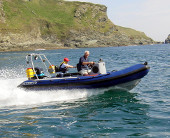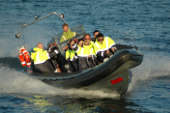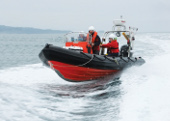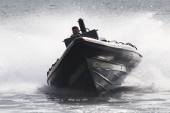
Are Performance and Durability important requirements?
If so, Chiorino provides the solution.
Rigid Inflatable Boat (RIB) Tubes
Chiorino RIB tube materials are manufactured using high-tenacity polyamide and coated with polyurethane to give the best possible performance, making them ideal for the most demanding applications and environments.
The base fabrics are specially designed to provide the ultimate in strength and impact energy absorption.
Our standard tube material, easily meets the requirements of ISO 15372 : 2000, a pre-requisite for SOLAS rescue RIBs.
Advantages of Chiorino Coated Fabrics polyurethane
- Better abrasion resistance (approximately 10x better than other commonly used coatings)
- Maintains the 'as new look' for longer
- Can be fabricated by welding as well as with adhesive
- Seams as strong as parent material
- Exceptionally good air-holding
- Higher strength / weight ratio
Polyurethane or 'Hypalon'/CSM?
As mentioned above, polyurethane tube materials from Chiorino offer a number of key performance advantages that favour its use for demanding applications, especially for military, police, commercial and RIB-safari applications, with the added benefit for all users that it keeps its ‘as new’ look for many years, even with hard usage.
The option to fabricate Polyurethane tubes by hot-air welding offers a significant reduction in fabrication costs for bulk quantities, and off-sets the higher material cost of Polyurethane compared with ‘Hypalon’.
However, an important advantage of ‘Hypalon’ is that it is available in a wider range of colours, and some of these, for example white, light grey and light blue, are not available in polyurethane.
For companies unable to justify the investment required to install hot-air welding, the lower material cost of ‘Hypalon’ is an important consideration.
Overcladding
Chiorino offer a choice of overcladding materials in polyurethane and in synthetic rubber.
Comparison of Material Used for Fenders
1. Overview
Weldable polyurethane coated textiles have been in use for over 40years. This type of coated fabric has established a reputation as the toughest and most reliable available for the most demanding applications.
Chiorino supply material reference 1PU5U5 for use as a premium-grade fender material. 1PU5U5 has been designed with performance, not cost, as our highest priority. As we all know, the lowest cost of purchase does not often lead to the lowest cost of ownership.
2. Characteristics of the material
The characteristics of the coated textile are determined by the properties of the base textile, the coating adhesion and the properties and thickness of the coating.
a) Base textile fabric
Yarns are often described in units called ‘decitex’ (dtx) which is the weight in grams of 10,000m of yarn. Therefore a 960dtx yarn, 10,000m long , would weigh 960g. And 10,000 metres of yarn designated 2200 dtx would weigh 2200g.
Knowing the decitex of the yarn used to make a fabric does not, by itself, indicate the tensile strength of the fabric itself. It is necessary to also know how tightly the yarns are packed together.
Our 1PU5U5 fabric has a panama weave design and packs as many yarns per cm into the construction as possible to give class-leading high tensile strength. A panama design is where two yarns are woven together as one.
The principal differences between polyester and polyamide (nylon) yarns are as follows:
Polyester is not very elastic and after being stretched does not fully regain its original length. Because of its high strength and ‘dimensional stability’ (it neither shrinks nor stretches very much) polyester fabric is used in applications where dimensional stability is particularly important, eg hoses, tyres and conveyor belts.
Polyamide (nylon) is about 50% more elastic than polyester and after stretching returns to its original length – this is called “elastic recovery”.
As a consequence, polyamide possesses an impact resistance significantly greater than that of polyester of the same tensile strength.
This same elasticity also allows localised stresses in a structure to be more distributed, so increasing the burst pressure.
It is for these reasons that we recommend using a polyamide base fabric for inflatable applications.
b) Adhesion
Chiorino have special coating systems that provide the best coating adhesion available in the market. High adhesion is an essential factor in providing the potential for high weld strength.
However, please note that higher adhesion with a given base fabric usually results in lower tear resistance. Nevertheless, high adhesion is more important.
In any PU joint that fails it is never the interface between weldable PU and weldable PU that fails, it is always the interface between the adhesive coat and the base fabric.
Please note that a fabric will not tear until it has either been broken (see tensile strength comment to follow) or punctured. 1PU5U5 has exceptionally good tensile strength and resistance to puncture.
c) the coating
Textile fibres and plastic coatings are composed of “polymers” – i.e. chains formed by the multiplication of smaller units (“monomers”) to form long chains. Linear polymers like polyurethane liquefy when heated. Polymers that act in this way are called “thermoplastic” and can be fabricated by welding.
There are essentially three types of coating on the market suitable for fenders:
PVC – where price rather than performance or durability is important. Performance is compromised at extreme high and at extreme low ambient temperatures. Can be fabricated by welding.
Rubber - long-established, but usually has to be fabricated by gluing, which is labour-intensive – also tends to cause marking.
Polyurethane – normally fabricated by welding.
Due to an abrasion resistance 10x better than rubber or PVC, is considered as non-marking.
Will withstand any ambient temperature. Can be fabricated by welding.
Description of the various coatings
a) PVC
PVC is a linear polymer and is, in pure form, rigid. That is why it can be used to make window frames, and is in this form designated UPVC = unplasticised PVC.
PVC is a very simple molecule easily made from low-cost components. When used as a coating on textiles it has to incorporate large quantities of plasticizers to make it flexible. As a consequence it is relatively weak and shows poor recovery after stretching. Nevertheless its performance can be quite adequate for some relatively undemanding fender applications. However, its performance remains well below that of polyurethane.
As time passes many plasticisers have a tendency to “migrate”, all the more so in hot conditions. This means that the plasticiser slowly moves towards the surface, causing a greasy film to form, and leaving behind areas where there is reduced plasticiser content, and hence reduced flexibility. As a result these areas are weakened and may present a potential to leak.
PVC tends to become stiff and brittle as the temperature gets well below freezing.
b) Rubber
For example Hypalon ( = CSM or chlorosulphonated polyethylene) and Neoprene
Different rubber formulations are used according to the nature of the application. Some 40 years or so ago rubber was far more important as a material for inflatable applications, but since that time polyurethane has gradually displaced rubber in more and more market segments, due to the technical and practical advantages offered by polyurethane.
Rubbers in general have a tensile strength about one third to one half that of polyurethane, and an abrasion resistance around one tenth that of polyurethane. Hence they need a much heavier coating to provide roughly equivalent performance.
Some rubbers will slowly degrade through contact with ozone, which limits shelf-life. Polyurethane is practically immune to ozone degradation and has an almost indefinite shelf life.
Most rubbers need to be fabricated with adhesive. Adhesives can be prone to failure after long exposure to extremes of high temperature and humidity.
c) Polyurethane
Polyurethane has a molecular structure which is complex and costly to manufacture, hence why it is much more expensive than PVC.
There are two main types of polyurethane used to coat textiles, polyester based and polyether based. Both can react with the free radicals produced by sunlight to form compounds of degradation that appear yellow.
To slow this process down we incorporate into our polyurethane coatings large quantities of high quality pigment to provide long-term protection. We use pigments that help to absorb UV and that “hide” as far as possible any yellowing of the polyurethane. It is important to recognise that this yellowing process is more of an aesthetic problem than a technical one. Given the use of appropriate pigments, polyurethane can perform satisfactorily for well over 10 years in areas of very high UV.
Polyurethane has far superior elastic recovery to that of PVC, and, in film form, is about 60% stronger in tensile strength than PVC.
The polyester grade of polyurethane should not be used in environments where it will not come into long-term contact with water. To the best of our knowledge, all polyurethane glues use polyester-based polyurethane, hence we do not recommend polyurethane glues for applications involving long-term contact with water. Instead, neoprene-based glues are recommended, and these work perfectly well with polyurethane. However, please note that neoprene-based glues may degrade after long-term exposure to light, so we recommend that any material covering the glue is checked for translucency.
For long-term contact with water, both salt and fresh, we recommend that polyether grade polyurethane, which has excellent resistance to degradation, should used.
The slow reforming of crystallinity after welding or exposure to solvent is why polyurethane takes more time to recover its strength after welding when compared with PVC.
Both grades of polyurethane have very good resistance to hydrocarbons such as petrol, diesel and oil. However, they are sensitive to aggressive solvents like acetone, MEK and toluene.
Welds of Chiorino polyurethane are exceptionally reliable, even after extended periods at high temperature and high humidity.
3. Gluing process
A key fact to remember here is that moisture adversely affects bond strength.
To achieve a good bond you need a chemical link between the polyurethane coating and the adhesive.
BUT if there is moisture present the adhesive will react preferentially with the moisture rather than with the polyurethane and bond adhesion is reduced.
The polyurethane itself will absorb moisture out of the air, as will the solvent, as will the adhesive, as will the cloth that is used to apply the solvent.
It is therefore most important to keep solvents and glues in sealed containers whenever possible.
If you use very dry solvent to pre-wipe before applying glue, this will take away moisture from the polyurethane and help to produce a good bond.
Do not use reclaimed solvent, this has a high moisture content.
The most appropriate solvents will depend upon the recommendations of your adhesive supplier, but normally we would recommend either acetone or MEK.
Obviously all of the recommended Health and Safety procedures, as provided by the solvent supplier, should be followed.
Best results are obtained with two-component adhesives, eg Bostik NE486 (+ Bostikure D).
4. Why opt for Chiorino polyurethane?
1) We use the highest performing base fabrics on the market
2) For our polyurethane mix we demand the best existing component materials
3) We add large quantities of pigment to our polyurethane to give it better UV resistance and so that it retains is “brand new” appearance longer
4) The adhesion of our polyurethane to the base fabric is the best in the market, thanks to the special technology employed
5) The combination of the more elastic polyamide fibre and a stronger fabric construction make our fabrics more impact resistant
6) Our customers tell us that products made from our materials outperform those made from competitive polyurethane materials
5. Precautions
a) If it is necessary to repair a fender, the area where the patch is to be applied must be carefully prepared by abrading. This is because with the passage of time polyurethane forms on its surface a very thin oxidised mico-layer that resists the penetration of solvents and adhesives
b) Certain types of aggressive hydrocarbons, such as acetone, MEK or toluene cause significant levels of swelling and weakening. This effect is temporary, and once the solvent has evaporated the polymer slowly regains its original characteristics. To fully recover can take over a day. Meanwhile that area will remain weakened and may crack if folded
c) A coated fabric will absorb water at the edges through exposed yarn. The process is called ‘capillary action’ or ‘wicking’. When this happens the absorbed water acts as a lubricant and locally lowers the level of adhesion. When the water later disperses the adhesion recovers. In fresh water in particular certain microbes can be absorbed along with the water which can attack the adhesive coating. So, it is for this reason that we recommend that any exposed edge that risks coming into regular contact with water should be sealed (using a tape of fine coated fabric or of polyurethane film).
d) Likewise air can also travel through yarn which is exposed both internally and externally, which is another reason why seam-sealing tapes are recommended.
6. Safety at work
There are no special precautions needed when handling polyurethane.
The polymer is USP approved for skin contact applications.
There is no plasticizer content.
There are no hydrogen chloride (acidic) fumes given off during welding operations, although it would be prudent to adopt the same precautions as are used for PVC. Like practically everything else there are toxic fumes given off if the material is overheated sufficient to cause degradation or burning.
Testimonials
"C-Trek is a Helsinki-based RIB safari company, specialised in offering action-packed maritime adventures.
We use RIBs designed and produced by the UK company Tornado Boats Ltd, which are equipped with tubes (collars) made from Chiorino PU.
It is vital to us that, not only should our RIBs actually be totally reliable, they should also maintain an as-new appearance that re-assures our customers that this is the case.
We have found that our Tornado RIBs match these requirements perfectly. The PU tubes stand up exceptionally well to the heavy usage involved in our bsiness."
"We have being working with Chiorino and using their PU fabrics for more than 10 years on our range of XS Commercial Rib Boats. We have found that the PU fabric outperforms all other options on the market for inflatable boats.
Our strongest markets are in Northern Europe and here the longevity and durability of the PU fabric has been well proven. It offers the best resilience we have found to the harsh working environment that many of our customers use our boats in"
"Tornado Boats International Ltd supply Rigid Inflatable Boats to a wide variety of governmental and commercial customers operating in the most extreme conditions, from sub-zero to equatorial. We chose to use Chiorino polyurethane for our tubes from the first day of manufacture.
This decision was based on having observed how Chiorino materials perform over many years in diverse environments and demanding usage in comparison to competitive materials.
Our own experience has matched expectations - tubes show superior durability and still look as new after several years of severe usage.
Our welded seams are totally reliable, long-term, no matter how high the ambient temperature, which is not always the case with glued seams."







